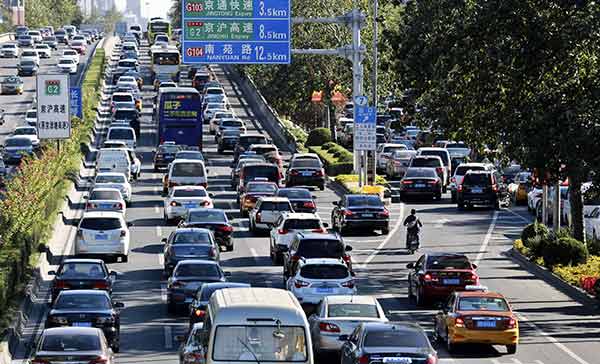
A traffic jam during peak hours in Beijing. The capital city currently has more than 5 million automobiles.(Photo: China Daily/Feng Yongbin)
Political advisers appear cautious about possible regulations on how to ease the traffic jam in Beijing just as most of cities in the country also face the same issues in China.
Some members of 12th Beijing Chinese People's Political Consultative Conference (CPPCC) expressed their concerns on easing the jam in the capital by charging congestion fees and limiting people's use of private vehicles.
Shi Xiangyang, a member of Beijing CPPCC, believes it's time for the municipal government to adjust their regulations on traffic.
"If the regulations cannot ease the congestions after it's been applied for over seven years, it is clearly not working. We have to change our approach," said Shi to China Daily website during the local CPPCC in Beijing on Thursday.
For past seven years, Beijing has implemented a regulation that bans cars with plate ending with two different numbers on each work day to keep down traffic volume.
On the days of heavy smog or special events, only half of the vehicles are allowed on the road.
Adviser Zhu Liang said it will inconvenience people's daily life if ban on half of all cars became a regular thing.
But Beijing is not even close to smooth flow of traffic.
According to a report released by taxi-hailing company Didi Dache, people in Beijing waste 7,972 yuan ($1,212) per person on traffic jams last year. On average, commuters in the city spent 52 minutes to complete a 19.2 km trip daily, the longest stretch compared to other Chinese cities.
Shi said the government needs to expand the public transportation services, such as subways and light rails, which are currently far insufficient to meet the demand.
Public transportation facilities should be comfortable and convenient to become the first choice when people plan to go out, he said. "This is the key point to solve the issue."
Shi said experiences from overseas metropolises serve good examples for Beijing on the thorny problem.
Tokyo, with less than five million cars in an area of more than 2,000 square kilometers, has a better traffic record than Beijing, which has six million cars in an area eight times bigger than Tokyo, added Shi.
"It's because of bad traffic management in Beijing," said Shi. "Limiting more cars and charging congestion fees may help a little in the begining, but it will be of little use when the numbers of cars keep growing."
He suggested the government should examine the causes of the worst-jammed road and come up with tailored solutions.
Earlier reports said the city is considering collecting congestion fees in certain downtown areas to reduce traffic. Similar measures have been used in other cities such as London.
But some advisers are also having a hard time agreeing on the idea.
"The congestion fee is not suitable for Beijing right now," said advisor Chen Xiaobing, He said the policy failed to touch the core problem, which is the lack of public transportation system.
"We have to be very cautious with lots of research and listening to voices from people," said Chen.


















































